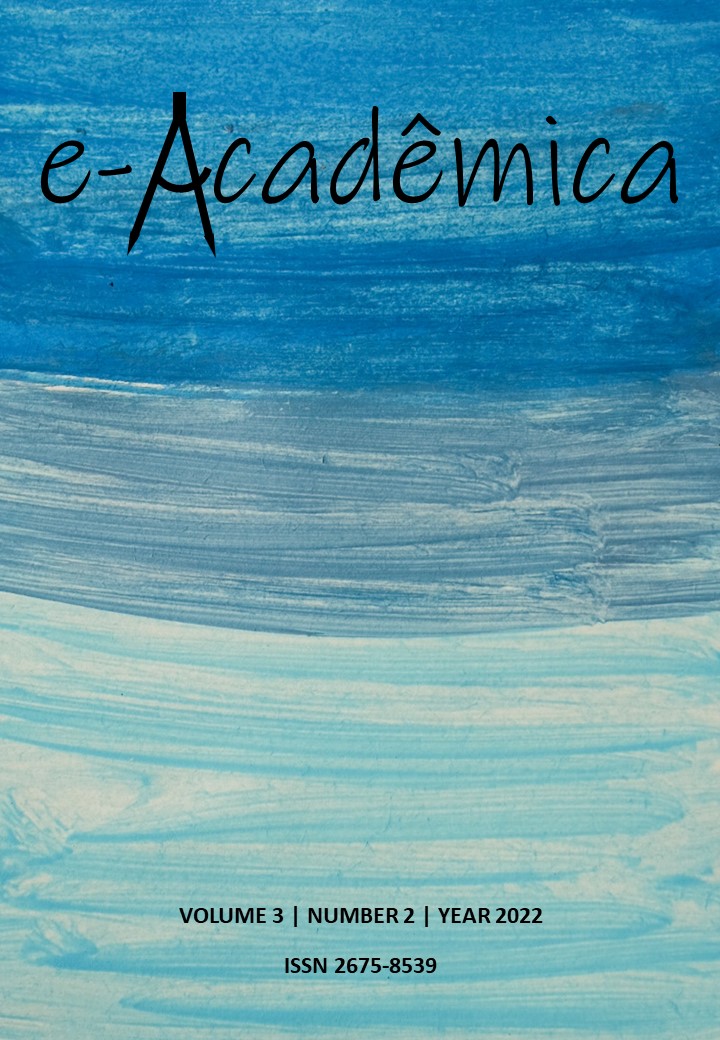The use of xylitol in minimally invasive dentistry
DOI:
https://doi.org/10.52076/eacad-v3i2.184Keywords:
Xylitol; Caries; Prevention.Abstract
Xylitol is a low-calorie sweetener, with several health benefits. In dentistry, the xylitol has been very important, as it has a lower oral bacteria fermentation and it act as a dental enamel remineralizing agent. This study aimed to investigate the presentations and use of xylitol and its applicability in caries prevention in minimally invasive dentistry. This study consists of a literature review, based on the search for complete articles, in English, selected in PubMEd and Scielo. Even though that the xylitol obtaining process is expensive, it presents as an additional way to treat and prevent caries lesions. When it is used in correct concentrations can be included in minimally invasive dentistry, especially in children with high caries risk, pregnant women and patients with special needs.
References
Anvisa. (2001). Resolução - RDC nº3, de 2 de janeiro de 2001 http://www.anvisa.gov.br/base/visadoc/res/res[1727-1-0].doc
Bahador, A., Lesan, S., & Kashi, N. (2012). Effect of xylitol on cariogenic and beneficial oral streptococci: a randomized, double-blind crossover trial. Iranian journal of microbiology, 4 (2), 75–81.
Cardoso, C. A., de Castilho, A. R., Salomão, P. M., Costa, E. N., Magalhães, A. C., & Buzalaf, M. A. (2014). Effect of xylitol varnishes on remineralization of artificial enamelcaries lesions in vitro. Journal of dentistry, 42 (11), 1495–1501. https://doi.org/10.1016/j.jdent.2014.08.009
Chi, D. L., Tut, O., & Milgrom, P. (2014). Cluster-randomized xylitol toothpaste trial for early childhood caries prevention. Journal of dentistry for children (Chicago, Ill.), 81 (1), 27–32.
Mäkinen, K. K., Bennett, C. A., Hujoel, P. P., Isokangas, P. J., Isotupa, K. P., Pape, H. R., Jr, & Mäkinen, P. L. (1995). Xylitol chewing gums and caries rates: a 40-month cohort study. Journal of dental research, 74 (12), 1904–1913. https://doi.org/10.1177/00220345950740121501
Mäkinen K. K. (2016). Gastrointestinal Disturbances Associated with the Consumption of Sugar Alcohols with Special Consideration of Xylitol: Scientific Review and Instructions for Dentists and Other Health-Care Professionals. International journal of dentistry, 2016, 5967907. https://doi.org/10.1155/2016/5967907
Marghalani, A. A., Guinto, E., Phan, M., Dhar, V., & Tinanoff, N. (2017). Effectiveness of Xylitol in Reducing Dental Caries in Children. Pediatric dentistry, 39 (2), 103–110.
Mitrakul, K., Srisatjaluk, R., Vongsawan, K., Teerawongpairoj, C., Choongphong, N., Panich, T., & Kaewvimonrat, P. (2017). Effects of short-term use of xylitol chewing gum and moltitol oral spray on salivary streptococcus mutans and oral plaque. The Southeast Asian journal of tropical medicine and public health, 48 (2), 485–493.
Cobos Ortega, Cinthya, Valenzuela Espinoza, Emilia, & Araiza, Miguel Ángel. (2013). Influencia de un enjuague a base de fluoruro y xilitol en la remineralización in vitro del esmalte en dientes temporales. Revista odontológica mexicana, 17 (4), 204-209. http://www.scielo.org.mx/scielo.php?script=sci_arttext&pid=S1870-199X2013000400002&lng=es&tlng=es.
Rafeek, R., Carrington, C., Gomez, A., Harkins, D., Torralba, M., Kuelbs, C., Addae, J., Moustafa, A., & Nelson, K. E. (2018). Xylitol and sorbitol effects on the microbiome of saliva and plaque. Journal of oral microbiology. 11 (1), 1536181. https://doi.org/10.1080/20002297.2018.1536181
Riley, P., Moore, D., Ahmed, F., Sharif, M. O., & Worthington, H. V. (2015). Xylitol containing products for preventing dental caries in children and adults. The Cochrane database of systematic reviews, (3), CD010743. https://doi.org/10.1002/14651858.CD010743.pub2
Rochel, I. D., Souza, J. G., Silva, T. C., Pereira, A. F., Rios, D., Buzalaf, M. A., & Magalhães, A. C. (2011). Effect of experimental xylitol and fluoride-containing dentifrices on enamel erosion with or without abrasion in vitro. Journal of oral science, 53 (2), 163–168. https://doi.org/10.2334/josnusd.53.163
Salli, K., Lehtinen, M. J., Tiihonen, K., & Ouwehand, A. C. (2019). Xylitol's Health Benefits beyond Dental Health: A Comprehensive Review. Nutrients, 11 (8), 1813. https://doi.org/10.3390/nu11081813
Siqueira, V. L., et al., (2021). Effect of xylitol varnishes on enamel remineralization of immature teeth: in vitro and in situ studies. Brazilian Oral Research, 35, e137. 2021.https://doi.org/10.1590/1807-3107bor 2021.vol35.0137
Smits, M. T., & Arends, J. (1985). Influence of xylitol- and/or fluoride-containing toothpastes on the remineralization of surface softened enamel defects in vivo. Caries research, 19 (6), 528–535. https://doi.org/10.1159/000260893
Söderling, E., Isokangas, P., Pienihäkkinen, K., Tenovuo, J., & Alanen, P. (2001). Influence of maternal xylitol consumption on mother-child transmission of mutans streptococci: 6-year follow-up. Caries research, 35 (3), 173–177. https://doi.org/10.1159/000047452
Xiao, J., Alkhers, N., Kopycka-Kedzierawski, D. T., Billings, R. J., Wu, T. T., Castillo, D. A., Rasubala, L., Malmstrom, H., Ren, Y., & Eliav, E. (2019). Prenatal Oral Health Careand Early Childhood Caries Prevention: A Systematic Review and Meta Analysis. Caries research, 53 (4), 411–421. https://doi.org/10.1159/000495187
Mussatto, S. I., & Roberto, I. C. (2002). Xilitol: edulcorante com efeitos benéficos para a saúde humana. Revista Brasileira De Ciências Farmacêuticas, 38(4), 401-413. https://doi.org/10.1590/S1516-93322002000400003
Haresaku S, Hanioka T, Tsutsui A, Yamamoto M, Chou T, & Gunjishima Y. Long-term effect of xylitol gum use on mutans streptococci in adults. Caries Res. 2007;41(3):198-203. 10.1159/000099318.
Downloads
Published
How to Cite
Issue
Section
License
Copyright (c) 2022 Thabata Louise Vieira Cherry; Guilherme Andreassa Gonçalves; Roberta Toshico dos Santos Okamoto; Caleb Shtisuka; Irineu Gregnanin Pedron; Thais Cordeschi

This work is licensed under a Creative Commons Attribution 4.0 International License.
Autores que publicam nesta revista concordam com os seguintes termos:
1) Autores mantém os direitos autorais e concedem à revista o direito de primeira publicação, com o trabalho simultaneamente licenciado sob a Licença Creative Commons Attribution que permite o compartilhamento do trabalho com reconhecimento da autoria e publicação inicial nesta revista.
2) Autores têm autorização para assumir contratos adicionais separadamente, para distribuição não-exclusiva da versão do trabalho publicada nesta revista (ex.: publicar em repositório institucional ou como capítulo de livro), com reconhecimento de autoria e publicação inicial nesta revista.
3) Autores têm permissão e são estimulados a publicar e distribuir seu trabalho online (ex.: em repositórios institucionais ou na sua página pessoal) a qualquer ponto antes ou durante o processo editorial, já que isso pode gerar alterações produtivas, bem como aumentar o impacto e a citação do trabalho publicado.










